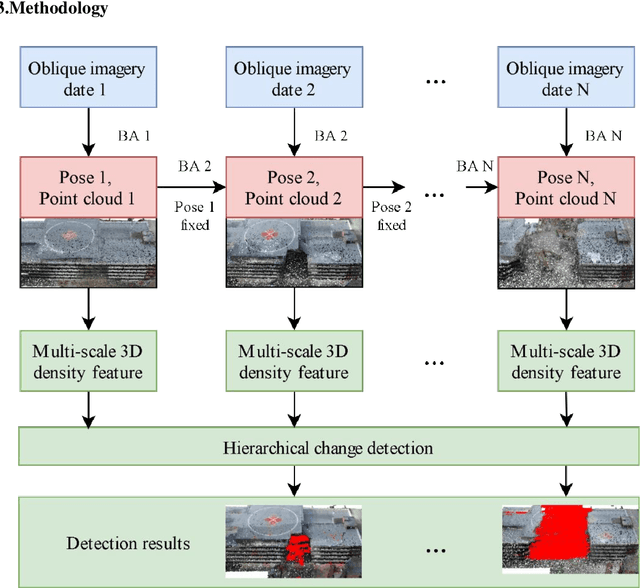Halil Sezen
Engineering deep learning methods on automatic detection of damage in infrastructure due to extreme events
May 01, 2022



Abstract:This paper presents a few comprehensive experimental studies for automated Structural Damage Detection (SDD) in extreme events using deep learning methods for processing 2D images. In the first study, a 152-layer Residual network (ResNet) is utilized to classify multiple classes in eight SDD tasks, which include identification of scene levels, damage levels, material types, etc. The proposed ResNet achieved high accuracy for each task while the positions of the damage are not identifiable. In the second study, the existing ResNet and a segmentation network (U-Net) are combined into a new pipeline, cascaded networks, for categorizing and locating structural damage. The results show that the accuracy of damage detection is significantly improved compared to only using a segmentation network. In the third and fourth studies, end-to-end networks are developed and tested as a new solution to directly detect cracks and spalling in the image collections of recent large earthquakes. One of the proposed networks can achieve an accuracy above 67.6% for all tested images at various scales and resolutions, and shows its robustness for these human-free detection tasks. As a preliminary field study, we applied the proposed method to detect damage in a concrete structure that was tested to study its progressive collapse performance. The experiments indicate that these solutions for automatic detection of structural damage using deep learning methods are feasible and promising. The training datasets and codes will be made available for the public upon the publication of this paper.
Automatic Displacement and Vibration Measurement in Laboratory Experiments with A Deep Learning Method
Sep 10, 2021



Abstract:This paper proposes a pipeline to automatically track and measure displacement and vibration of structural specimens during laboratory experiments. The latest Mask Regional Convolutional Neural Network (Mask R-CNN) can locate the targets and monitor their movement from videos recorded by a stationary camera. To improve precision and remove the noise, techniques such as Scale-invariant Feature Transform (SIFT) and various filters for signal processing are included. Experiments on three small-scale reinforced concrete beams and a shaking table test are utilized to verify the proposed method. Results show that the proposed deep learning method can achieve the goal to automatically and precisely measure the motion of tested structural members during laboratory experiments.
A volumetric change detection framework using UAV oblique photogrammetry - A case study of ultra-high-resolution monitoring of progressive building collapse
Aug 05, 2021



Abstract:In this paper, we present a case study that performs an unmanned aerial vehicle (UAV) based fine-scale 3D change detection and monitoring of progressive collapse performance of a building during a demolition event. Multi-temporal oblique photogrammetry images are collected with 3D point clouds generated at different stages of the demolition. The geometric accuracy of the generated point clouds has been evaluated against both airborne and terrestrial LiDAR point clouds, achieving an average distance of 12 cm and 16 cm for roof and facade respectively. We propose a hierarchical volumetric change detection framework that unifies multi-temporal UAV images for pose estimation (free of ground control points), reconstruction, and a coarse-to-fine 3D density change analysis. This work has provided a solution capable of addressing change detection on full 3D time-series datasets where dramatic scene content changes are presented progressively. Our change detection results on the building demolition event have been evaluated against the manually marked ground-truth changes and have achieved an F-1 score varying from 0.78 to 0.92, with consistently high precision (0.92 - 0.99). Volumetric changes through the demolition progress are derived from change detection and have shown to favorably reflect the qualitative and quantitative building demolition progression.
End-to-end Deep Learning Methods for Automated Damage Detection in Extreme Events at Various Scales
Nov 05, 2020



Abstract:Robust Mask R-CNN (Mask Regional Convolu-tional Neural Network) methods are proposed and tested for automatic detection of cracks on structures or their components that may be damaged during extreme events, such as earth-quakes. We curated a new dataset with 2,021 labeled images for training and validation and aimed to find end-to-end deep neural networks for crack detection in the field. With data augmentation and parameters fine-tuning, Path Aggregation Network (PANet) with spatial attention mechanisms and High-resolution Network (HRNet) are introduced into Mask R-CNNs. The tests on three public datasets with low- or high-resolution images demonstrate that the proposed methods can achieve a big improvement over alternative networks, so the proposed method may be sufficient for crack detection for a variety of scales in real applications.
 Add to Chrome
Add to Chrome Add to Firefox
Add to Firefox Add to Edge
Add to Edge